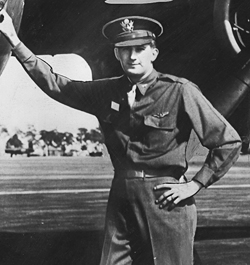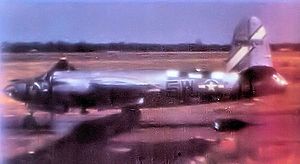Elmer Gedeon facts for kids
Quick facts for kids
Elmer Gedeon
|
|
|---|---|
 |
|
| Born | April 15, 1917 Cleveland, Ohio, US |
| Died | April 20, 1944 (aged 27) Saint-Pol, German-occupied France |
| Place of burial | |
| Allegiance | |
| Service/ |
|
| Years of service | 1941–1944 |
| Rank | |
| Unit | 586th Bomb Squadron, 394th Bombardment Group |
| Battles/wars | World War II
|
| Awards | |
| Alma mater | University of Michigan |
Elmer John Gedeon (born April 15, 1917 – died April 20, 1944) was an American professional baseball player. He played in a few games for the Washington Senators in 1939. Elmer Gedeon and Harry O'Neill were the only two Major League Baseball players who died during World War II.
Gedeon flew several missions in Europe as an officer in the United States Army Air Forces. He was shot down over France during a mission. Before joining the military, Gedeon was a talented college athlete. He was an All-American in track and field at the University of Michigan. He also earned awards in football and baseball. In 1938, he even tied a world record in the high hurdles.
Gedeon's baseball career ended when he was called to serve in the United States Army in 1941. He trained to be a bomber pilot. He was honored for his bravery after his plane crashed during a training flight in 1942. Later, he flew in combat missions. He was killed while piloting a B-26 bomber over France in April 1944.
Contents
Early Life in Cleveland
Elmer Gedeon was born on April 15, 1917, in Cleveland, Ohio. He was a great athlete at Cleveland's West High School. He graduated in 1935. Standing 6 feet 4 inches tall, he was excellent in American football, baseball, and track and field.
One time, when he was young, Gedeon was ice skating in Cleveland. The ice broke, and his cousin fell into the water. His cousin remembered that Elmer slid on his stomach across the ice to pull him out. Elmer's uncle, Joe Gedeon, was also a Major League Baseball player. He was involved in the Chicago Black Sox scandal, a famous baseball event.
College Sports Achievements
Gedeon started at the University of Michigan in 1935. There, he earned special awards in three sports: baseball, football, and track and field.
Track and field was Gedeon's best sport. He won the Big Ten Conference championship twice in high hurdles. In March 1938, Gedeon tied an American indoor record. He then tied a world record at the Illinois Relays. He also helped Michigan win the Big Ten indoor track and field meet in March 1939. Michigan won both the outdoor and indoor championships in 1938–1939. In 1938, he became an All-American in track and field.
Gedeon also played football for the Michigan Wolverines football team from 1936 to 1938. He earned three awards in football. In 1937, a story about the team said Gedeon could pass, punt, and run very fast. In 1938, Gedeon played end for Coach Fritz Crisler. That year, Coach Crisler introduced the famous "winged football helmet" at Michigan.
In baseball, Gedeon played both first base and in the outfield for the Michigan Wolverines baseball team. He earned two awards in baseball and had a good batting average of .320.
Professional Baseball Career
| Elmer Gedeon | |||
|---|---|---|---|
| Outfielder | |||
|
|||
| debut | |||
| September 18, 1939, for the Washington Senators | |||
| Last appearance | |||
| September 24, 1939, for the Washington Senators | |||
| MLB statistics | |||
| Games played | 5 | ||
| At bats | 15 | ||
| Hits | 3 | ||
| Teams | |||
|
|||
After graduating in the summer of 1939, Gedeon signed with the Washington Senators. He chose baseball over a chance to be on the USA's track team for the 1940 Summer Olympics.
Gedeon was a promising player. Clark Griffith, the president of the Senators, spoke about him to The Sporting News. He called Gedeon an "exciting new player." Gedeon first played for a minor league baseball team in Orlando, Florida. He played in 67 games in 1939. In September, he was called up to the major leagues. He played in five games as an outfielder. He got three hits, scored one run, and had one RBI. His three hits came in a game against the Cleveland Indians on September 19.
In 1940, Gedeon went to spring training with the Senators. He hoped to earn a spot in the outfield or at first base. He returned to the minor leagues and played for the Charlotte Hornets. He hit .271 in 131 games. He was called up again in September but did not play in any games.
Military Service and Death in World War II
In January 1941, Gedeon was called to join the military. He reported to the Army instead of going to spring training. He was assigned to the Cavalry Replacement Center at Fort Riley. He joked in a letter to his fraternity brothers that "the only horse I ever saw in my life was the one the milkman used."
On October 22, 1941, Gedeon was accepted into pilot training. He joined the United States Army Air Forces. He earned his pilot's wings and became a second lieutenant in May 1942. He trained to fly twin-engined bombers.
On August 9, 1942, Gedeon was flying as a navigator in a B-25 bomber. The plane crashed into a swamp during takeoff. Gedeon managed to crawl out of the burning plane. Even though he had burns and three broken ribs, he went back into the wreckage. He rescued a crewmate who had serious injuries. Two other crew members died in the crash. Gedeon spent 12 weeks in the hospital recovering. He received the Soldier's Medal for his bravery.
"I'll be back in baseball after the war," he said on his last leave before going overseas. His cousin remembered him saying, "I had my accident. It's going to be good flying from now on." He believed he had used up all his bad luck. In February 1943, the Associated Press wrote a story about Gedeon's war service. He was quoted saying he hoped to return to baseball if the war ended soon enough.
In July 1943, Gedeon joined the 586th Bomb Squadron. This group trained with Martin B-26 Marauder bombers. In February 1944, the group went to RAF Boreham, England. Gedeon became a Squadron Operations Officer and began flying combat missions in Europe. His first mission was to attack an airfield in France on March 23, 1944.
On April 20, 1944, Gedeon piloted one of 36 B-26 bombers. They left RAF Boreham to attack a V-1 "buzz bomb" site in France. The group faced heavy anti-aircraft fire. Gedeon's plane was hit by flak (anti-aircraft shells) just after bombing. Gedeon's co-pilot, whose clothes were on fire, was able to parachute from the bomber. However, Gedeon and five other crew members died when the plane crashed.
Gedeon was first reported as missing in action. It was not until May 1945 that his family learned his grave had been found in France. Gedeon's remains were later brought back to the United States. He was buried in Arlington National Cemetery.
More than 500 major league players served in World War II. Gedeon and Harry O'Neill were the only two players killed. Both were 27 years old. They have become symbols of "baseball's sacrifice" during the war. The National Baseball Hall of Fame and Museum says: "Ballplayers, like every other American citizen, understand the importance of giving one's self for their country." After the war, a scholarship was created in Gedeon's name at the University of Michigan.
In 1983, Gedeon was added to the University of Michigan Athletic Hall of Honor. This was for his achievements in both track and baseball.
Awards and Decorations
 |
||
| Badge | U.S. Army Air Forces Aviator Badge | |||||||||||
|---|---|---|---|---|---|---|---|---|---|---|---|---|
| 1st row | Soldier's Medal | |||||||||||
| 2nd row | Air Medal | Purple Heart | American Defense Service Medal | |||||||||
| 3rd row | American Campaign Medal | European-African-Middle Eastern Campaign Medal with 1 Campaign star |
World War II Victory Medal | |||||||||
See also
 In Spanish: Elmer Gedeon para niños
In Spanish: Elmer Gedeon para niños
- List of baseball players who died during their careers



